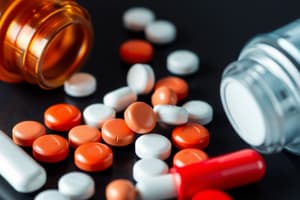Podcast
Questions and Answers
Which antihypertensive drug type lowers blood pressure by inhibiting calcium influx into the muscle cells of blood vessel walls?
Which antihypertensive drug type lowers blood pressure by inhibiting calcium influx into the muscle cells of blood vessel walls?
- Beta-blockers
- CCBs (correct)
- Central acting agents
- Diuretics
What is a common side effect associated with ARBs?
What is a common side effect associated with ARBs?
- Fatigue
- Headache
- Hyperkalemia (correct)
- Dehydration
For which condition are beta-blockers commonly used?
For which condition are beta-blockers commonly used?
- Edema
- Migraine (correct)
- Anxiety disorders
- Hypertension
Peripheral adrenergic inhibitors lower blood pressure by:
Peripheral adrenergic inhibitors lower blood pressure by:
What is a potential concern when prescribing antihypertensive drugs and medications for erectile dysfunction?
What is a potential concern when prescribing antihypertensive drugs and medications for erectile dysfunction?
Which antihypertensive drug class blocks the conversion of angiotensin I to angiotensin II?
Which antihypertensive drug class blocks the conversion of angiotensin I to angiotensin II?
How do Angiotensin II Receptor Blockers (ARBs) work to lower blood pressure?
How do Angiotensin II Receptor Blockers (ARBs) work to lower blood pressure?
Which antihypertensive drug class acts on the central nervous system to reduce blood pressure?
Which antihypertensive drug class acts on the central nervous system to reduce blood pressure?
What is the mechanism of action of ACE inhibitors and ARBs in lowering blood pressure?
What is the mechanism of action of ACE inhibitors and ARBs in lowering blood pressure?
Which antihypertensive drug class helps the kidneys remove excess sodium and water from the body?
Which antihypertensive drug class helps the kidneys remove excess sodium and water from the body?
Flashcards are hidden until you start studying
Study Notes
Antihypertensive Drugs: An Overview
Antihypertensive medications help lower blood pressure (BP) to reduce the risk of cardiovascular diseases and stroke. They fall into several classes, each offering distinct mechanisms of action and potential side effects.
Types of Antihypertensive Drugs
- Angiotensin-Converting Enzyme (ACE) inhibitors: Block the conversion of angiotensin I to angiotensin II, leading to vasodilation. Examples include lisinopril and enalapril.
- Angiotensin II Receptor Blockers (ARBs): Prevent angiotensin II from binding to its receptor, also causing vasodilation. Examples include losartan and valsartan.
- Calcium Channel Blockers (CCBs): Prevent calcium from entering smooth muscle cells, relaxing blood vessels. Examples include amlodipine and verapamil.
- Diuretics: Help the kidneys remove excess sodium and water from the body, reducing blood volume and BP. Examples include furosemide and hydrochlorothiazide.
- Beta-blockers: Reduce heart rate and cardiac output, thereby lowering BP. Examples include atenolol and metoprolol.
- Central acting agents: Act on the central nervous system to reduce BP. Example: clonidine.
- Peripheral adrenergic inhibitors: Block the release of norepinephrine from nerve endings, reducing BP. Example: reserpine.
Mechanism of Action
- ACE inhibitors and ARBs: Lower BP by reducing the effects of angiotensin II, which leads to vasodilation and decreased aldosterone secretion.
- CCBs: Facilitate the relaxation of blood vessels by inhibiting calcium influx into the muscle cells of blood vessel walls.
- Diuretics: Lower BP by reducing blood volume through an increase in urine output.
- Beta-blockers: Lower BP by decreasing heart rate and cardiac output.
- Central acting agents: Lower BP via central nervous system mechanisms.
- Peripheral adrenergic inhibitors: Lower BP by blocking the release of norepinephrine from nerve endings.
Common Side Effects
- ACE inhibitors: Hypokalemia (low potassium levels), hyperkalemia (high potassium levels), angioedema, and kidney impairment
- ARBs: Hypokalemia, hyperkalemia, and kidney impairment
- CCBs: Headache, constipation, dizziness, and peripheral edema
- Diuretics: Increased urination, dehydration, electrolyte imbalances, and gout
- Beta-blockers: Fatigue, cold extremities, slowed heart rate, and reduced exercise ability
- Central acting agents: Dry mouth, dizziness, drowsiness, and depression
- Peripheral adrenergic inhibitors: Dizziness, dry mouth, postural hypotension, and sedation
Indications and Drug Interactions
- ACE inhibitors and ARBs: Used for heart failure, diabetic nephropathy, and proteinuria in nondiabetic chronic kidney disease
- CCBs: Used for hypertension, angina, and vasospastic disorders
- Diuretics: Used for hypertension, edema, and fluid retention
- Beta-blockers: Used for angina, heart failure, and arrhythmias
- Central acting agents: Used for hypertension, migraine, and anxiety disorders
- Peripheral adrenergic inhibitors: Used for hypertension and migraine
Drug interactions should be considered when prescribing antihypertensive medications. Some antihypertensive drugs may interact with medications for depression, erectile dysfunction, and immunosuppression.
Studying That Suits You
Use AI to generate personalized quizzes and flashcards to suit your learning preferences.




